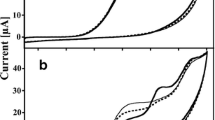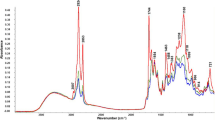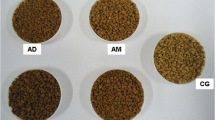Abstract
Sensory-guided fractionation of a roasted coffee brew by means of sequential solvent extraction, ultrafiltration, and RP-HPLC demonstrated a group of ethyl acetate soluble compounds formed from O-hydroxycinnamoyl quinic acid derivatives upon coffee roasting as the key compounds contributing to the bitter taste of roasted coffee beverages. LC-MS/MS studies, 1D- and 2D-NMR spectroscopy, syntheses, and model roast experiments with 5-O-caffeoyl- and 5-O-feruloylquinic acid led to the unequivocal identification of 3-O-caffeoyl-γ-quinide (2a), 4-O-caffeoyl-γ-quinide (3a), 5-O-caffeoyl-epi-δ-quinide (4a), 4-O-caffeoyl-muco-γ-quinide (5a), 5-O-caffeoyl-muco-γ-quinide (6a), 3-O-feruloyl-γ-quinide (2b), and 4-O-feruloyl-γ-quinide (3b) as intense coffee bitter tastants. Besides these individual bitter compounds, a highly complex and intensely bitter HPLC fraction was isolated from the ethyl acetate extractables of coffee brew. Application of COSY spectroscopy and alkaline hydrolytic degradation gave strong evidence that the bitter taste of that fraction is due to a multiplicity of rather complex quinic acid lactone isomers multiply esterified with p-coumaric acid, caffeic acid, ferulic acid, 3,4-dimethoxycinnamic acid, and quinic acid, respectively. As representatives of this fraction, 3,4-O-dicaffeoyl-γ-quinide (10), 3,5-O-dicaffeoyl-epi-δ-quinide (11), and 4,5-O-dicaffeoyl-muco-γ-quinide (12) have been isolated, purified, and identified as strongly bitter-tasting compounds in roasted coffee. For the first time, bitter taste recognition thresholds were determined for the individual compounds showing that, strongly depending on their chemical structure, the bitter threshold levels ranged between 9.8 and 180 μmol/l (water).








Similar content being viewed by others
References
Semmelroch P, Grosch W (1995) Lebensm Wiss Technol 28:310–313
Semmelroch P, Grosch W (1996) J Agric Food Chem 44:537–543
Mayer F, Czerny M, Grosch W (2000) Eur Food Res Technol 211:272–276
Chen WC (1979) Doctoral Thesis, University of Munich
Shibamoto T, Harada K, Mihara J, Nishimura K, Yamaguchi A, Aitoku A, Fukada T (1981) In: Charambous G, Inglett G (eds) The quality of foods and beverages, Vol 2, Academic Press, New York, p. 311
Belitz HD (1975) Flavor-active substances in coffee. ASIC, 7th Colloquium, Hamburg, ASIC Bremen 1977, pp 243–252
Ginz M, Engelhardt UH (2001) Eur Food Res Technol 213:8–13
Rizzi GP, Boekley LJ, Ekanayake A (2004) In: Shahidi F, Weerasinghe DK (eds) Nutraceutical beverages—chemistry, nutrition, and health effects, ACS Symposium Series 871, Washington, DC, pp 229–236
Ginz M, Engelhardt UH (2001) Analysis of bitter fractions of roasted coffee by LC-ESI-MS—new chlorogenic acid derivatives, Proceedings to the ASIC symposium, 2001, Trieste, Italy
Maga JA (1978) CRC Crit Rev Food Sci Nutr 10:323–372
McCamey DA, Thorpe TM, McCarthy JP (1990) In: Rouseff RL (ed) Bitterness in foods and beverages, Elsevier, London, pp 169–182
Frank O, Hofmann T (2001) J Agric Food Chem 49:231–238
Ottinger H, Bareth A, Hofmann T (2001) J Agric Food Chem 49:1336–1344
Czepa A, Hofmann T (2003) J Agric Food Chem 51:3865–3873
Ottinger H, Hofmann T (2003) J Agric Food Chem 51:6791–6796
Scharbert S, Holzmann N, Hofmann T (2004) J Agric Food Chem 52:3498–3508
Engel W, Bahr W, Schieberle P (1999) Eur Food Res Technol 209:237–241
Sefkow M (2001) Eur J Org Chem 1137–1141
de Paulis T, Lovinger DM, Martin P (2004) US Patent; US 6,693,128 B2
Huynh-Ba T (1995) United States Patent; Patent No.: US 5,401,858
Bennat C, Engelhardt UH, Kiehne A, Wirries FM, Maier HG (1994) Z Lebensm Unters Forsch 199:17–21
Farah A, DePaulis T, Trugo LC, Martin PR (2005) J Agric Food Chem 55:1505–1513
Wynne KN, Familari M, Boublick JH, Drummer OH, Rae ID, Funder JW (1987) Clin Exp Pharmacol Physiol 4:785–790
Morishita H, Iwahashi H, Osaka N, Kido R (1984) J Chromatogr 315:253–260
Author information
Authors and Affiliations
Corresponding author
Rights and permissions
About this article
Cite this article
Frank, O., Zehentbauer, G. & Hofmann, T. Bioresponse-guided decomposition of roast coffee beverage and identification of key bitter taste compounds. Eur Food Res Technol 222, 492–508 (2006). https://doi.org/10.1007/s00217-005-0143-6
Received:
Accepted:
Published:
Issue Date:
DOI: https://doi.org/10.1007/s00217-005-0143-6




